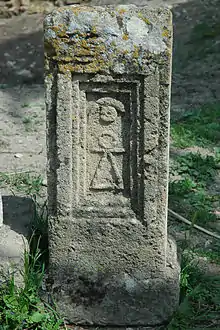Sign of Tanit
The sign of Tanit or sign of Tinnit is an anthropomorph symbol present on many archaeological remains of the Punic Civilization.

Representations
The symbol has been the subject of various representations but for which one can note constants: a triangle, a linear shape with sometimes the two branches raised and a disc at the top. The first representations of the sign were reported on stele unearthed on the site of Carthage from the beginning of the 19th century. Archaeological excavations have subsequently uncovered representations on other supports such as mosaics or even on ceramics.
The excavations of tophet of Carthage, Sousse and Motya have highlighted the particularly important diffusion of the symbol in the western basin of the Mediterranean Sea, although the few discoveries on primitive Phoenician land may only be due to continued occupation of sites making searches more difficult.[1]
Signification
The symbol called the sign of Tanit was related to the goddess of the same name, paredre of Ba'al Hammon in the Punic pantheon from the first discoveries. The proximity of the sign with the Egyptian anse cross (ankh) was put forward, the linkage of Punic Carthage with the pharaonic civilization can corroborate this origin. It was perceived as a representation of the connection of the terrestrial or chthonic world with the celestial world, the two raised branches being two arms raised in prayer. The motif has also been interpreted as having an apotropaic purpose, the Punics being eager to protect themselves from the evil eye.
Modern use
Both the symbol and the name of the goddess Tanit are still frequently used within Tunisian culture such as with the tradition of Omek Tannou[2] or the grand film prize of the Tanit d'or.[3] Some scholars also relate the name of the capital Tunis and by extension the one of the modern country and its people to the Phoenician goddess Tanith ('Tanit or Tanut), as many ancient cities were named after patron deities.[4][5]
See also
References
- Lipinski, Edward (1992). Dictionnaire de la civilization phénicienne et punique. Brepols. ISBN 2503500331.
- Rezgui, Sadok (1989). Les chants tunisiens. Maison tunisienne de l'édition, Tunis.
- IMDb, awards
- Room, Adrian (2006). Placenames of the World: Origins and Meanings of the Names for 6,600 Countries, Cities, Territories, Natural Features, and Historic Sites. McFarland. p. 385. ISBN 978-0-7864-2248-7.
- Taylor, Isaac (2008). Names and Their Histories: A Handbook of Historical Geography and Topographical Nomenclature. BiblioBazaar, LLC. p. 281. ISBN 978-0-559-29668-0.




